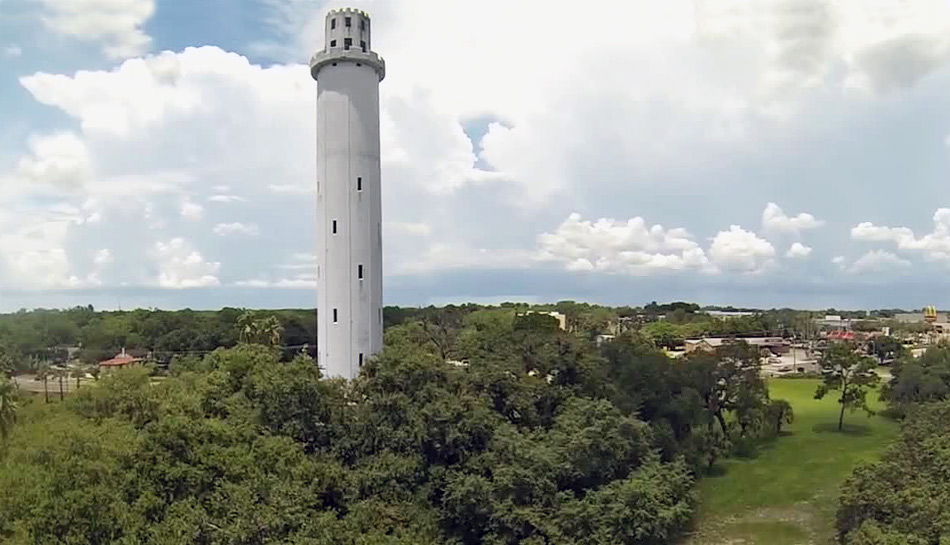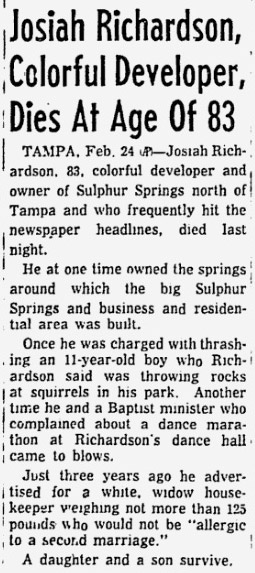|
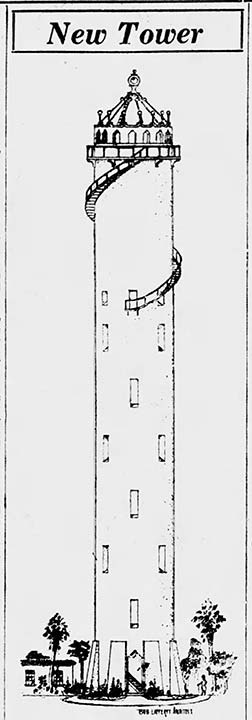 |
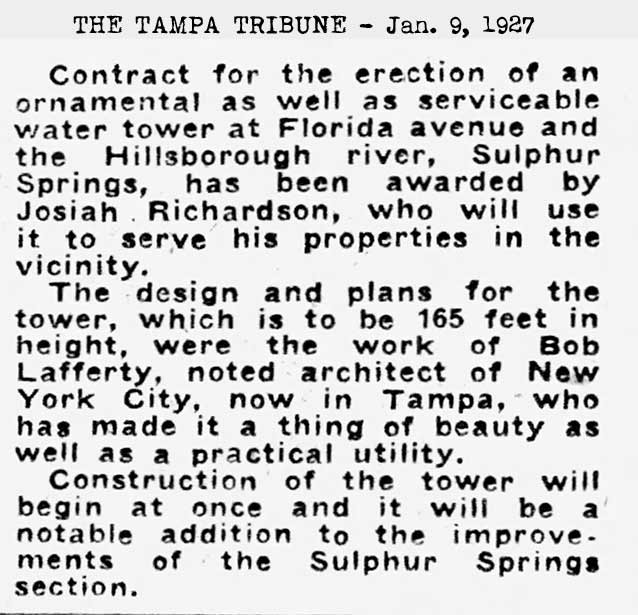
The Sulphur Springs Water
TowerCompletion of the
Hotel/Arcade in 1927 created the need for water to service it, so
Josiah Richardson
mortgaged all of his assets, including the 100 acres of Sulphur
Springs and the Hotel/Arcade, to build a $180,000 water tower.
This is around $2.5 Million in 2018 dollars.
The expansion of the
community into a bustling tourist destination and real estate market
would not have been possible without the creation of the water tower to
bring the necessary water to its businesses, patrons, and residents.
On
Jan. 9, 1927, it was announced in the local newspaper that the contract
for the tower was awarded to Bob Lafferty, a New York architect.
|
|
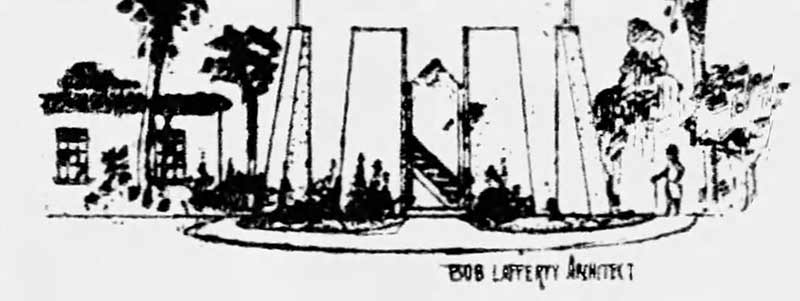
Apparently, this
design was modified somewhat, perhaps for a more economical design
but taller tower. Lafferty, who had
been living in Tampa for 3 years, left for New York and other major
cities in May of 1927 in order to promote his idea of "Airway
transportation systems" involving cars traveling on suspended cables.
|
|
May 1927 -
Construction begins
|
A rare photo of
the indomitable Josiah S. Richardson at the time the tower and
arcade were being built. |
|
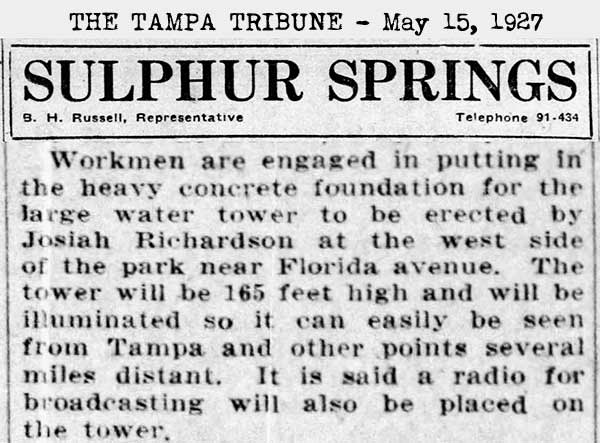
Initially, the tower
was to be 165 feet tall, but the construction update on Sept. 11
states that it will be 200 feet tall.
Sept. 11,
1927: Workers were working at a feverish pace, with a day and
night shift.
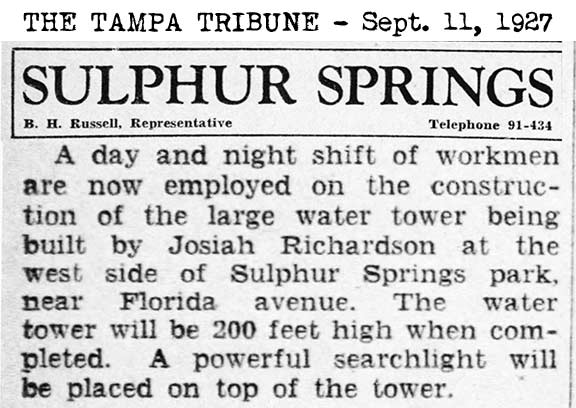
The photo to the
right was published on Sept. 16. Three levels of windows can be
seen, which puts it at an estimated 1/3 completed.
In an amazing
accomplishment, the tower was completed EIGHT DAYS later.
This Tampa Times article claims the tower had an electric
elevator, but that wasn't so. Richardson's plans for the
tower went down the drain with the flood of 1933. See the
end of this page concerning the flood and Richardson's plans for
the tower.
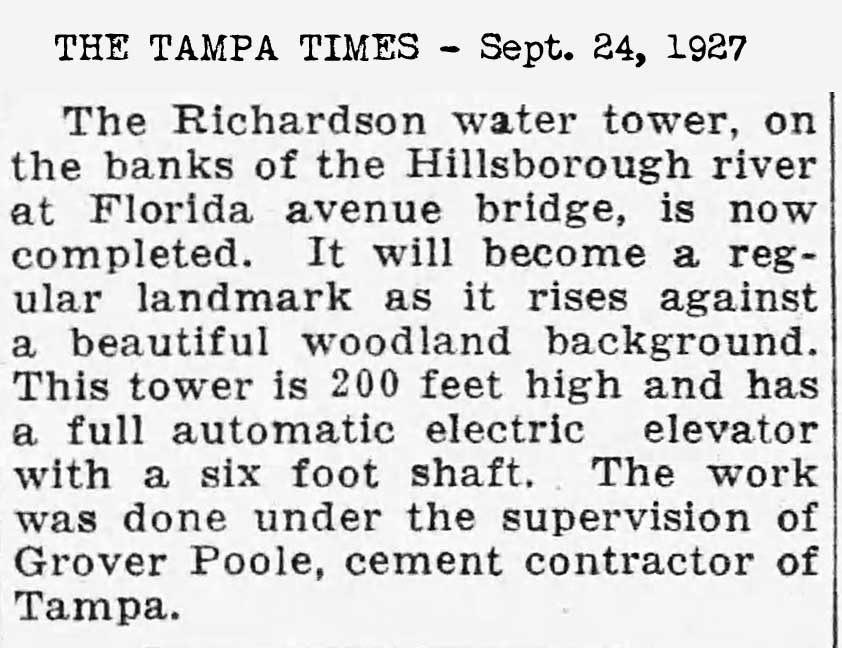
|
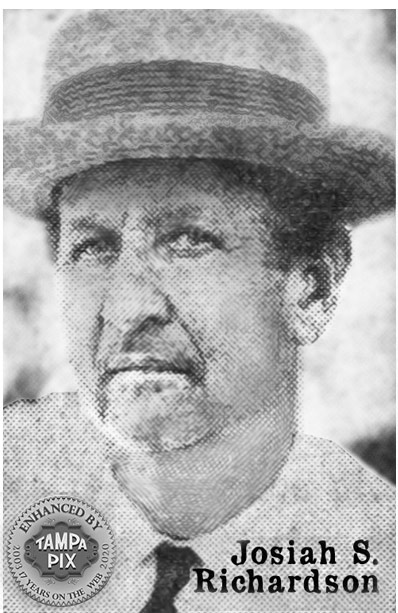
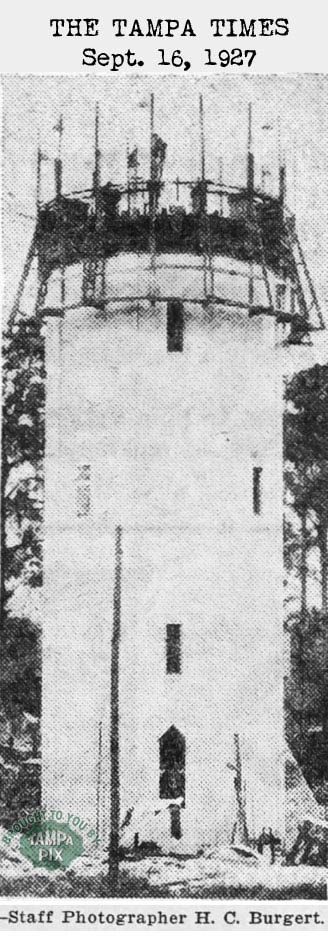 |
|
There was not a "Burgert brother" with the initials of H. C.
Harry Burgert's full name was James Harold Burgert. Will
Burgert's full name was Willard Chesney Burgert. However, if
the initials are correct, H.C would be a son of James
Harold "Harry" Burgert. While in Key West, Harry met and
married Jeanette "Nettie" B. Johnson, a Key West native. In
1900, Harry and Nettie's first son was born in Key West--Harold
"Hal" Chesney Burgert. (H.C.) In 1904, Nettie and Harry had
their second son, Ethelbert "Thel" James Burgert. Thel and
his brother Hal would eventually become well-known photographers
and work for newspapers in Detroit, MI.
Read
about the Burgert Brothers here at TampaPix
|
|
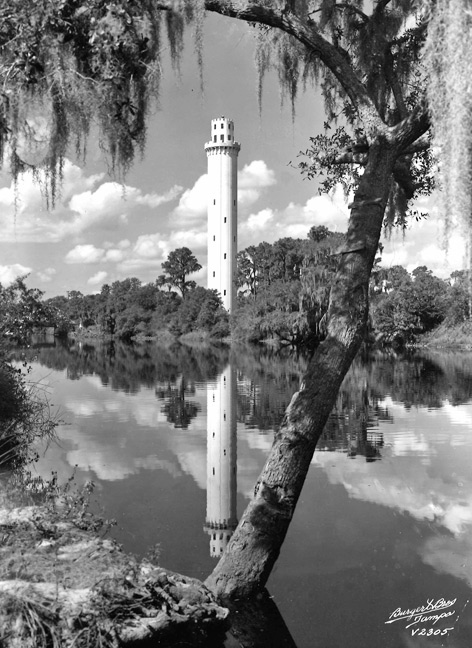
The Sulphur Springs water
tower, 1945
Burgert Brothers photo courtesy of
David Parsons, Tampa-Hillsborough County Public Library.
Place your cursor on the photo to see it close up. |
The Sulphur Springs water tower is
located on 13 acres of grassland on the banks of the
Hillsborough River. It combines utilitarian function and
architectural vision with its elaborate detailing, crenellated
parapet walls, lancet windows, and scrolled footings.
The 214-foot-tall
Gothic Revival tower is one of only two such structures
remaining in Florida. According to currently accepted
histories of the tower, its design and construction was
overseen by civil engineer Grover Poole. "Poole designed it to look like a
medieval tower, with slit windows and battlements crowning the
holding tank." If it was actually designed by Poole, then
it can be concluded that Lafferty's design (and contract) was
rejected for reasons yet to be determined.
Constructed of poured-in-place concrete, with eight-inch- thick
walls, the structure sits on a 45-foot deep foundation
blasted into solid bedrock, with a
buttressed base over a artesian spring.
Richardson had steel railroad rails brought in from north
Florida to reinforce the concrete. Grover Poole wrote:
"Concrete was poured into forms that were
raised by yokes and jacks -- 10 feet went up a day. The
tower rests on rock, has a cantilever foundation, and with the
buttresses will be rather a difficult job to ever destroy."
The tower is built over the opening of an
artesian well with pumps located under the tower itself.
Another building was on the property which housed fluoridation and
filtering equipment when the water company was in business piping
water directly to customers.
|
| When it was operational, it stored
136,000 gallons of water
pumped up from the artesian well. (Some sources says
200,000 gallons.) The water tank
occupied the upper quarter of the cylindrical tower while seven
floors, one room per floor, constitute the lower three quarters. |
|
When the tower was filled
with water to service the tourist camps along Florida Avenue,
the Arcade facility and upstairs hotel, Richardson miscalculated the
power and speed with which the water would make its way from the top of
the tower to the faucets below. Legend has it that when the first
faucet was opened the rushing water blew the fixtures off the walls.
Richardson's plans included an
elevator to carry people up the central core cylinder to the observation
balcony, which provided a panoramic view of this bucolic river
setting.
Not much
is known about the tower's builder, Grover Poole. Public records show that he was born
Nov. 27, 1886 in Lovington, Illinois and held various occupations
in his lifetime. In 1910 in Macon, Illinois he was
a draughtsman (draftsman) for the railroad. In 1917 when he registered for
the WW1 draft, he was a minister and supt. of a grain elevator,
listing himself as a pastor in Arzenville, Ill. Around 1919, he
married Ora Davis and in 1920
they lived in Tanners Creek, Norfolk Co, VA. In the 1920s, he
lived in Decatur, ILL and worked as a grain elevator contractor.
By 1930 he lived in Auburn, Al where he worked as a construction
engineer. He and Ora had a 6 year old
son John G. Poole. He may not have lived in Tampa while working
on the Sulphur Springs water tower; he is only listed in Tampa's 1933
city directory as a building inspector. Florida's 1935 census
finds him in Clewiston, Hendry County, Florida, as a Civil Engineer with
a university education. On the 1940 census he was in Montgomery, MD.
His occupation was business
manager, Jr. College. In 1942 he was a business manager for National
Park College in Forest Glen, MD.
From its completion until 1971, the water
tower was operated by a private water company piping artesian well
water to commercial and residential customers in the immediate
vicinity.
|
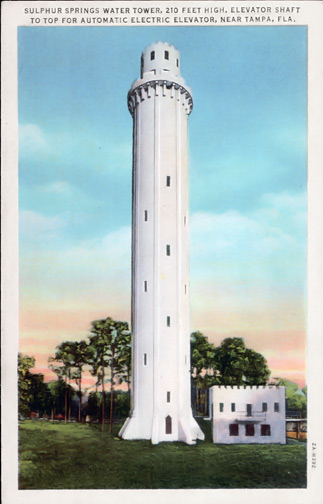
This undated
postcard shows the water treatment building next to the tower.
Hillsboro News Co. postcard from the University of Florida
digital collection, no date. Postcard reverse side:
 |
|
In 1971 the owner of the
water company and tower was "The Estate of J.F. Hendricks" (several
beneficiaries under his will including surviving relatives). They were
forced by the City of Tampa in 1971 to cease water piping operations so
that the City's water utility company could maintain a monopoly over the
business of piping water to citizens. |
|
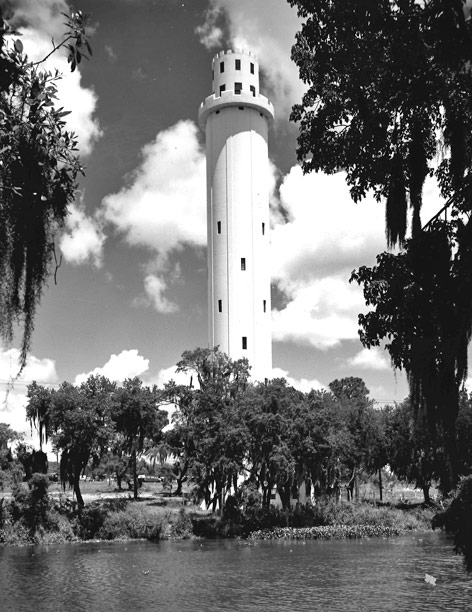
The Sulphur Springs water
tower in 1954.
Burgert
Brothers photo courtesy of David Parsons, Tampa-Hillsborough
County Public Library |
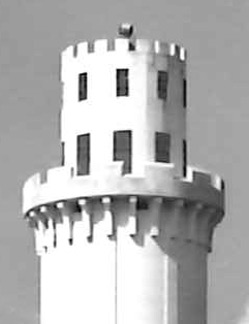 |
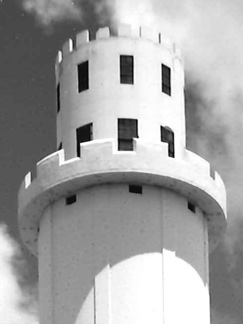 |
|
Sometime from 1945 to
1954, the decorative supports under the parapet were removed. |
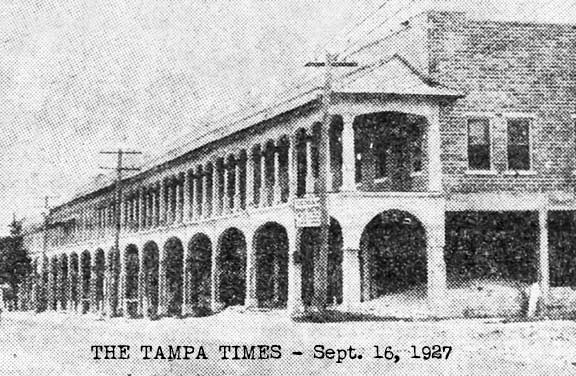
|
|
|
|
|
|
| Watch and listen to this
mesmerizing video by Mike Littlefield. The spectacular views
of the tower along with the music captures the adventurous
character that was Josiah Richardson and his epic dreams for
Sulphur Springs. |
| |
| Mike has several
dramatic videos of the water tower and surrounding area, along
with other spectacular drone videos.
See them on his YouTube page. |
THE FOLLOWING SECTION WILL BE
UPDATED SOON
The Flood
of 1933 and the Great Depression
Intense rainfall associated with the tropical hurricane of September
4, 1933, which passed across central Florida northwesterly from the
Atlantic Ocean, caused severe damage in Sulphur Springs and the failure
of the Tampa Electric Company dam on the Hillsborough River on September
7, 1933. Sudden
release of the stored waters washed out bridges, overflowed banks in the
lower river reaches, and sent water surging through town.

Sulphur Springs Flooded As
Huge Dam Bursts Open
- The Evening Independent, Sept. 8, 1933
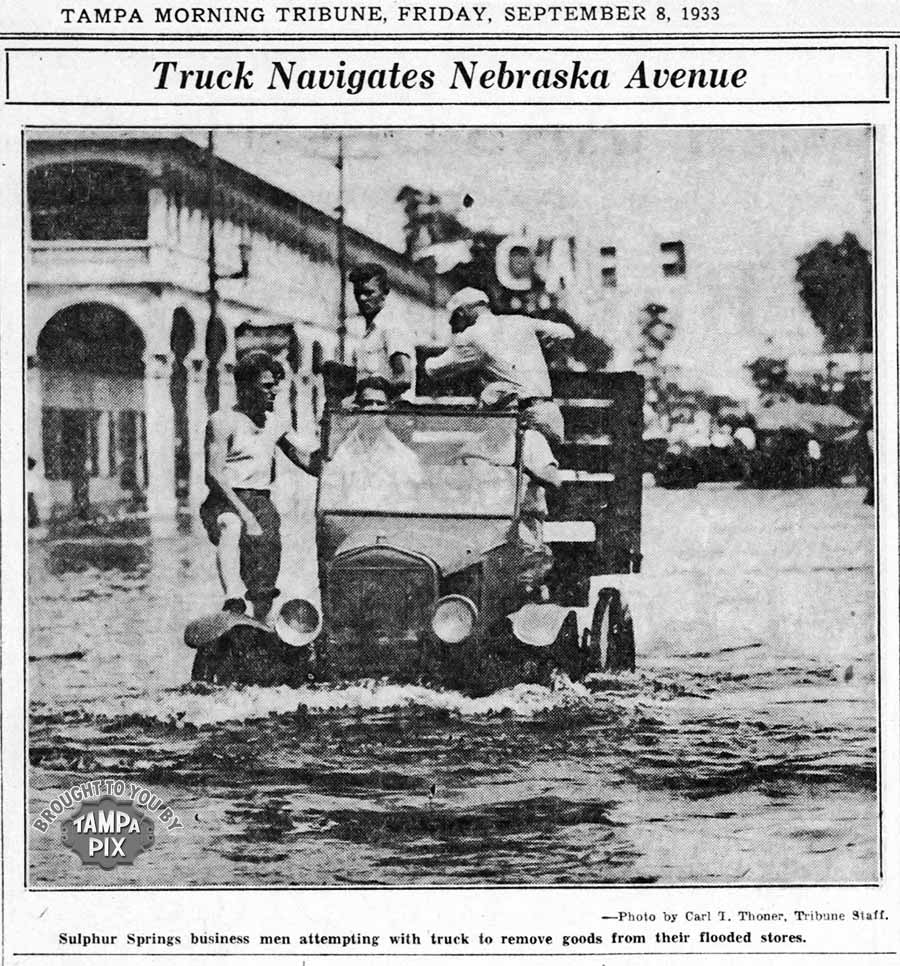
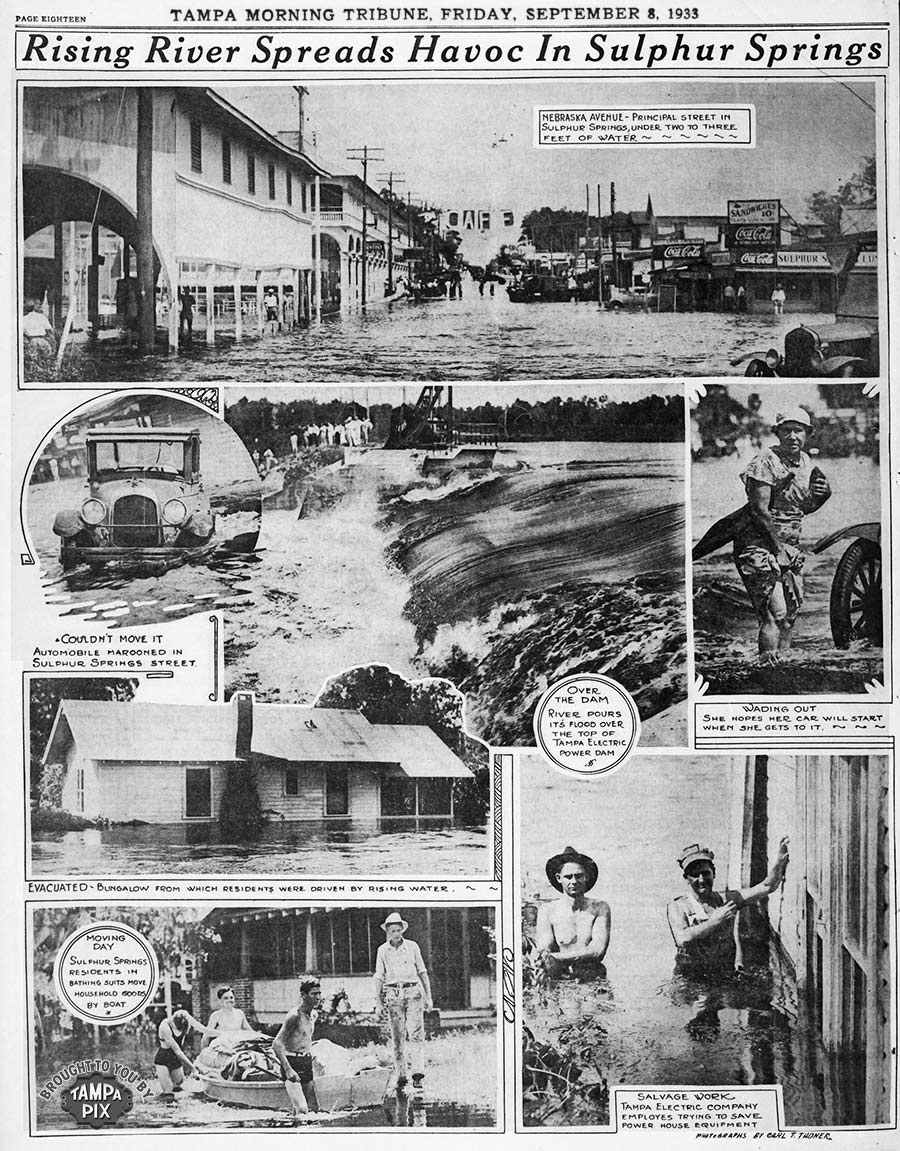
Tampa Suburb Faces Flood As Dam Breaks, The Palm Beach Post, Sept. 8,
1933
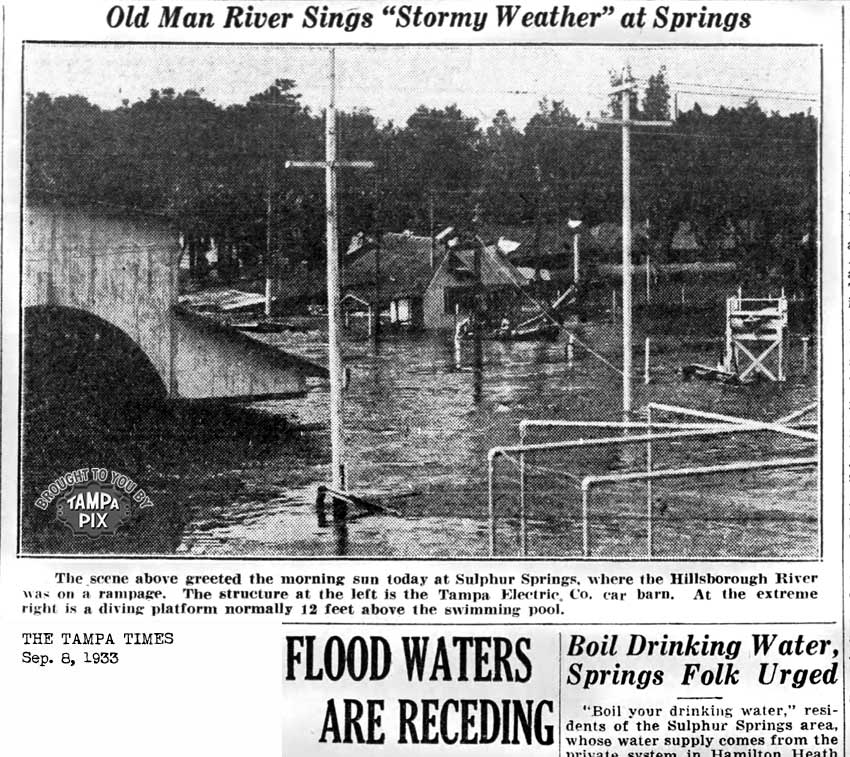
Sulphur Springs Flood Subsiding, St. Pete Times, Sept. 9, 1933
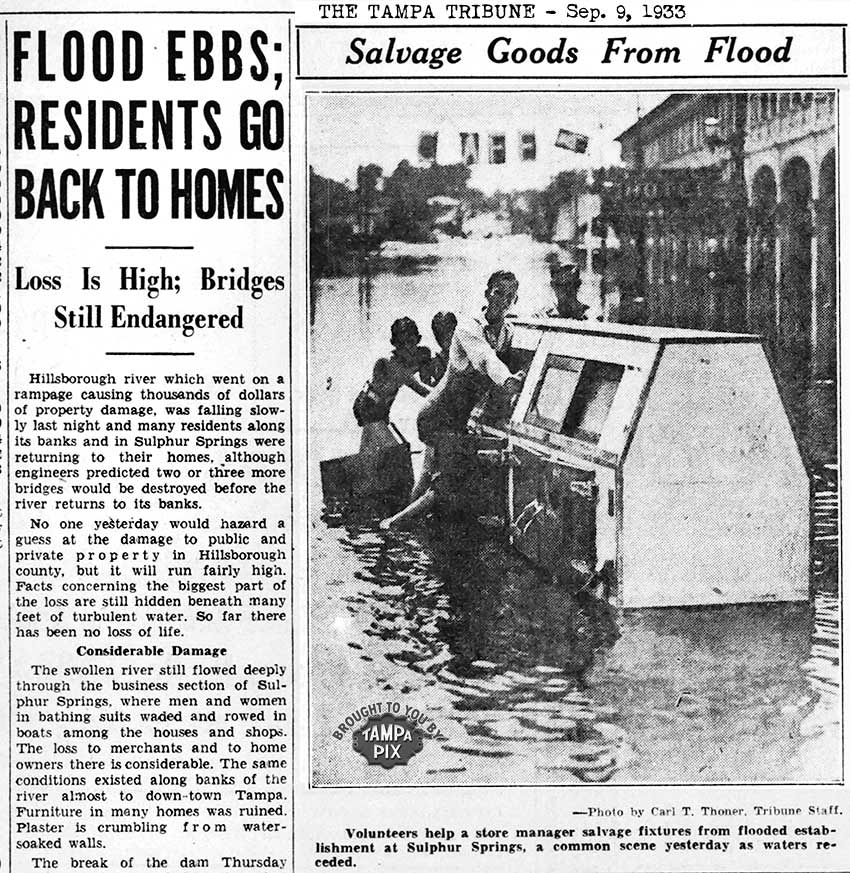
Sulphur Springs Homes Flooded, St. Pete Times, Sept. 10, 1933
Flood Refugees Appeal For Aid, 100 Families Left Penniless by
Catastrophe, St. Pete Times, Sept. 11, 1933
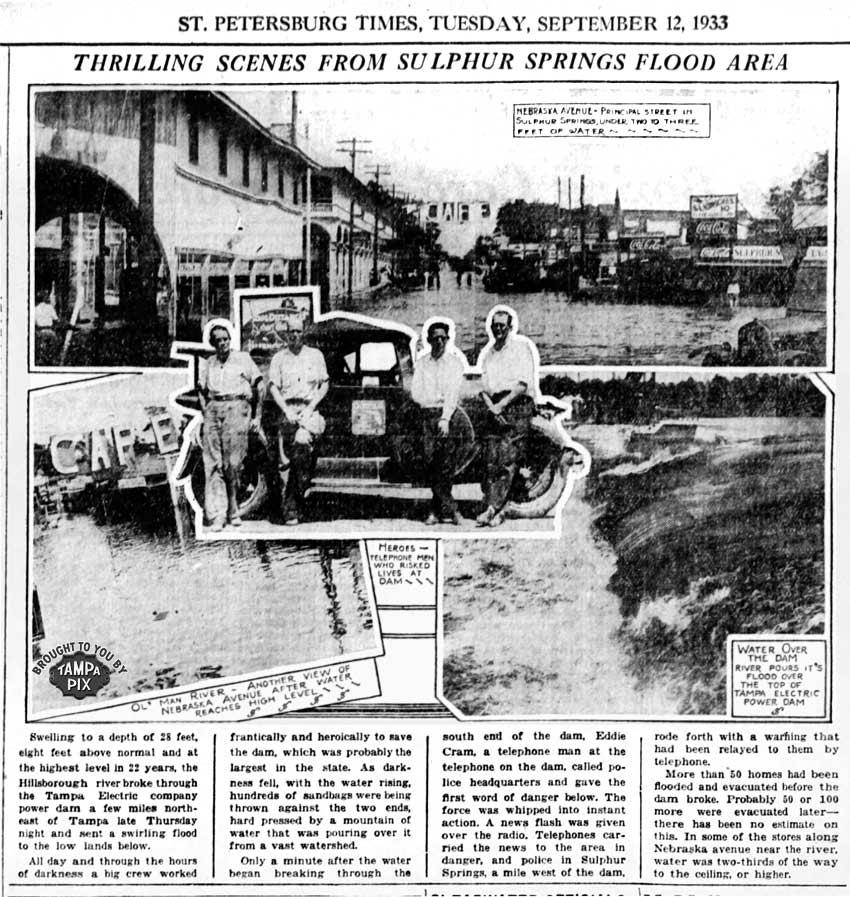
|
Along with the
flood came the effects of the Great Depression, which greatly diminished
tourism dollars spent in Sulphur Springs.
Both events caused the merchants and residents of the Arcade to default
on their rent payments, leaving Richardson without funds to pay the
mortgage on the Arcade. Richardson was forced to sell his Sulphur
Springs holdings to South Carolina tobacco grower J.F. Hendrick before
his vision was fully realized. He never built the elevator,
observation balcony or the club rooms in the water tower.
The hotel and arcade's glory days in the 1940s and '50s progressed under
new ownership. The spring continued to be popular with tourists and
residents alike and remained a central part of the community where
people came to swim, picnic, and shop at the Arcade. After the death of Hendrick, the property passed to his five grandchildren. They, as estate
holders, exerted control over leases for the ground floor stores. In
order to "bring in new businesses, they refused lease renewals for many
of the original shops.
Sulphur Springs was, in
effect, a planned community, in that first Dr. John Mills and then
Josiah Richardson, purchased the land for the purpose of developing the
community of Sulphur Springs as a tourist and recreation area for
profit. Through a series of misfortunes, poor timing, wars, floods, and
a national depression, its success was somewhat limited mostly to the seasonal
invasions of middle class Northerners. The Sulphur Springs
community never incorporated as a township and was eventually annexed by
the City of Tampa in 1953. In the runoff election for mayor of
Tampa in 1956, Nick Nuccio accused then-interim Mayor J. L. Young (who
became mayor after the death of Mayor Curtis Hixon) of trying to
obstruct the growth of Tampa by seeking to incorporate Sulphur Springs
as a separate community in order to prevent Tampa from annexing it.
|
|
The Tower
Drive-In Theatre
|
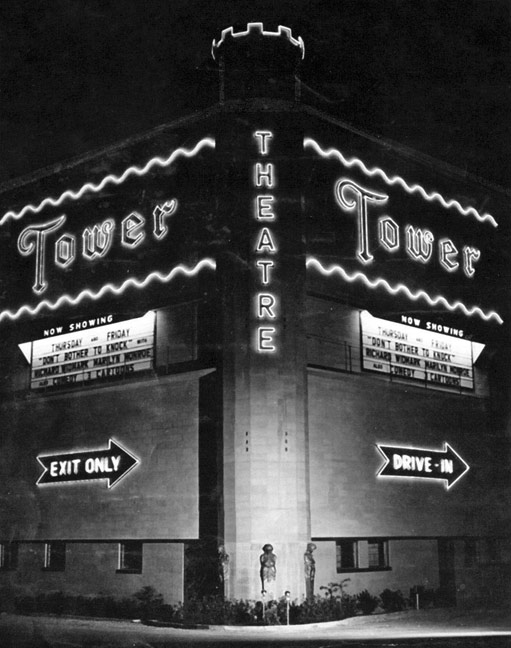 |
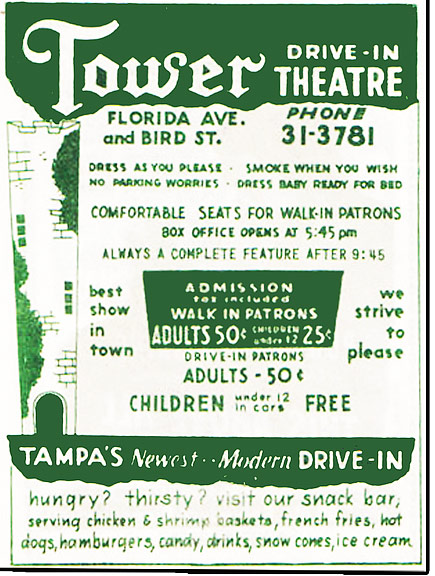 |
|
The Tower Drive-in marquee
and entrance, 1952. It was on Bird Street, just east of the
water tower. The screen was on the opposite side of the
building, facing south toward the river. The movie feature
in this photo was "Don't Bother to Knock" with Richard Widmark,
Marilyn Monroe and Anne Bancroft. Photo courtesy of Johnny
Cinchett,
Vintage Tampa Signs and Scenes |
Newspaper ad and
program from
Cinema Treasures |
The Tower Drive In opened on October 22, 1952 with
the double feature “Wait Till The Sun Shines Nellie” and “Dakota Lil.”
This is the grand opening ad with a photo of the lot. The
huge full-page ad contained congratulatory announcements
from about 20 merchants and supply companies. The venue had
a capacity of 300 cars and closed down in the 1980s.
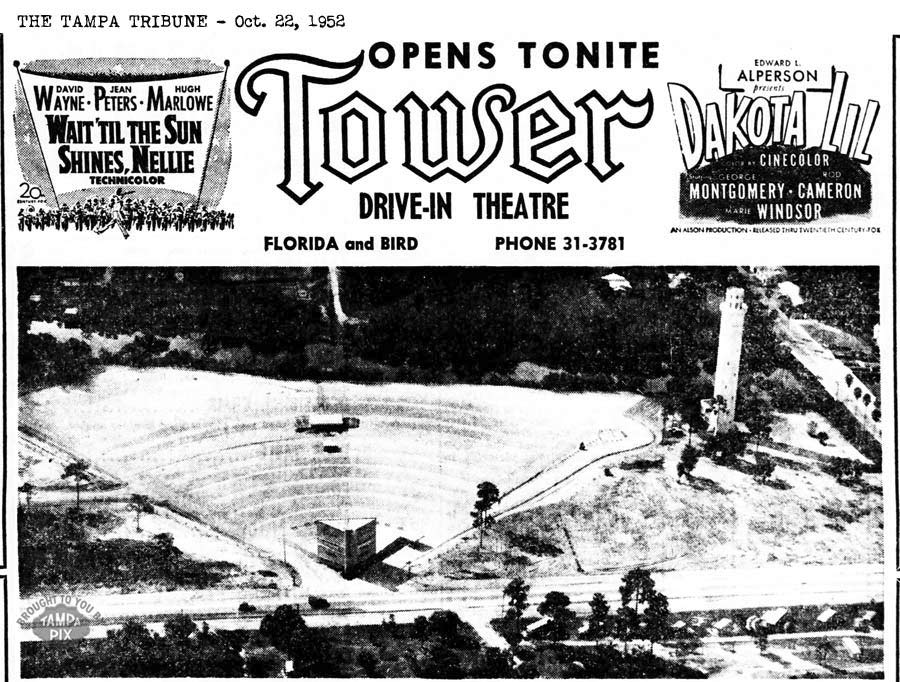
|
Above image from larger article seen below.
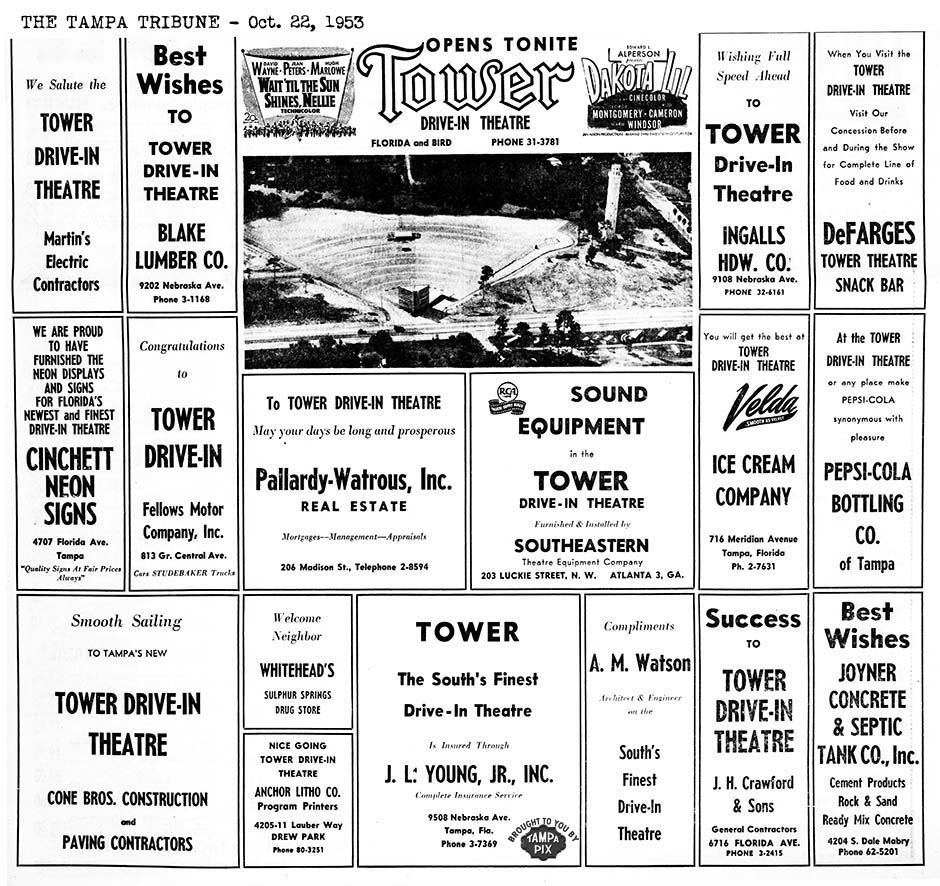
|
While the Sulphur Springs
neighborhood experienced changing economies and population shifts, the
Sulphur Springs water tower continued operating.
A flood in the 1960s weakened the arcade's foundation, and in following
years the building's upkeep was neglected. Interstate construction
in the late 1960s cut through Sulphur Springs, and a drug culture that
took off in the 1970s and '80s saw the neighborhood decline.
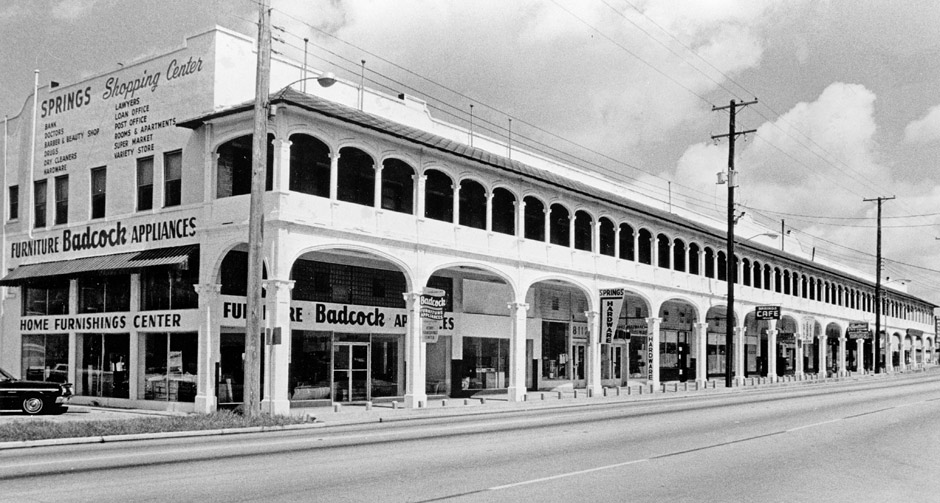
Sulphur Springs Arcade, 1975
Photo from the Library of Congress
|
| Before the arcade's
destruction, residents could shop at Maves five-and-dime, Badcock
Furniture & Appliances, Sanders and Whitehead's drugstores, and Linder's
Jewelry. Through the years, the "city under one roof" saw dozens of
businesses come and go: a bank, a bakery, drugstores, grocery stores, a
hardware store, a liquor store, a pool hall, a barber shop, a post
office and a sheriff's office. The hotel and the shops remained until 1975
and in 1976, the entire building was demolished and made into a parking
lot for the nearby greyhound racing track. |
|

